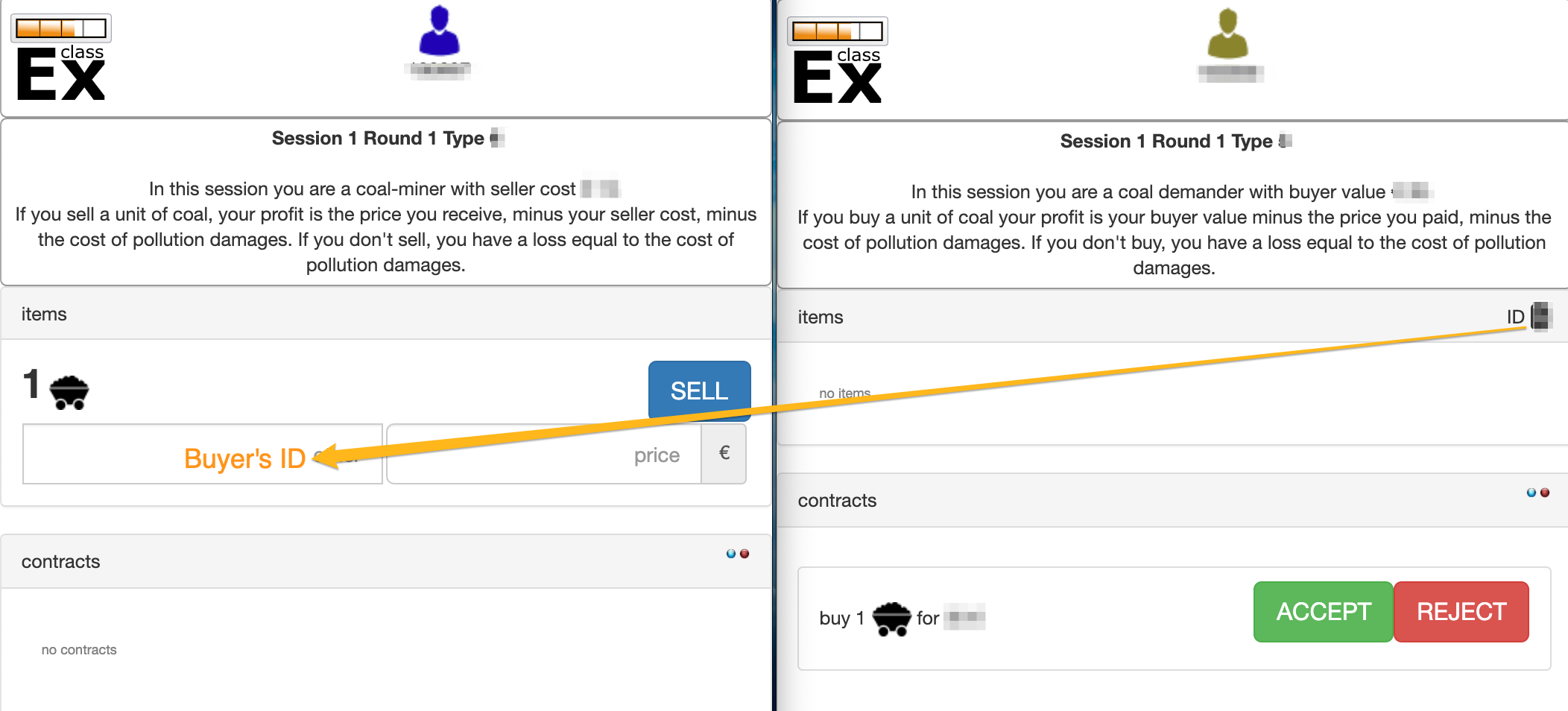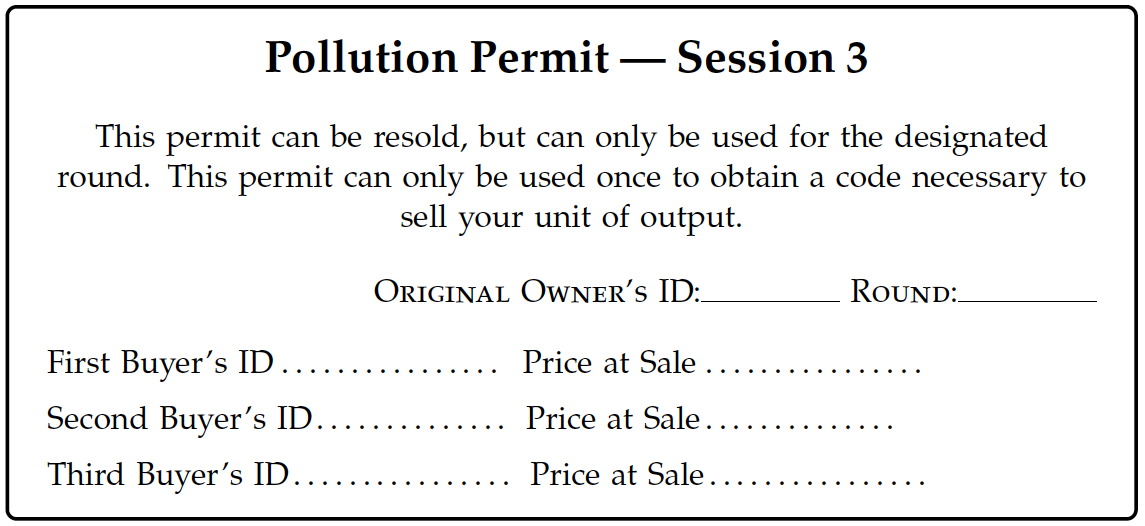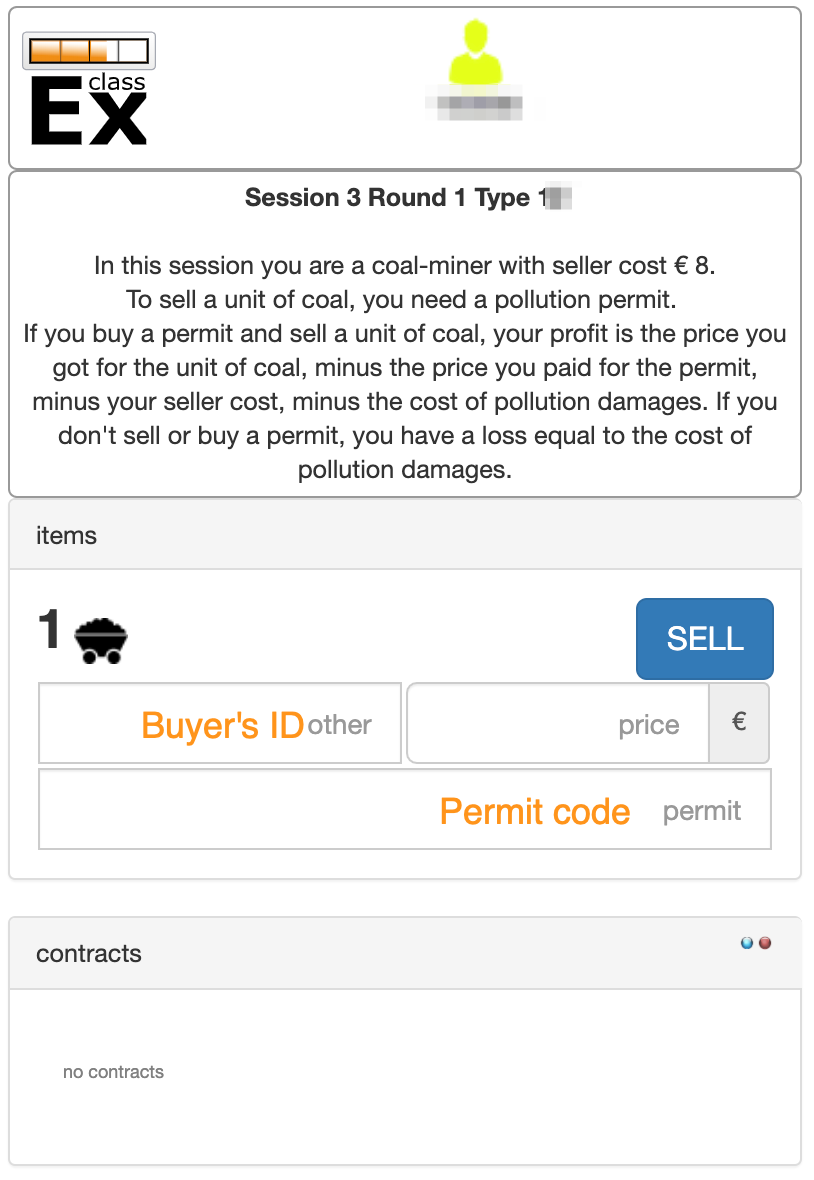Version 1.01, October 2019
Winter nights get cold on the Isle of Effluvia. With heavy blankets, one can get along without heat, but a warm fire is much appreciated, especially by those whose houses are not well insulated. The surrounding seas are turbulent, the coastal shores are treacherous, and no trading boats can bring fuel. Solar panels and green technology have not reached Effluvia. The only available fuel is locally-mined coal, which Effluvians burn in old coal stoves. Heating a house requires 1 unit of coal. Coal stoves pollute the air, emitting soot particles that penetrate deep into the lungs of all Effluvians.
The island has a coal market where residents can buy coal from the mine-owners. Each unit of coal that is purchased will result in additional pollution that harms all Effluvians. Because of this pollution, trades that benefit both the buyer and seller have side-effects that harm others not involved in the transaction. Such side-effects are known as harmful externalities. Because of these externalities, unrestricted trade in the coal market will lead to an inefficient outcome in which “too much” coal is burned. This experiment explores market interventions that are designed to reduce the amount of pollution and to benefit all Effluvians.

In this experiment you will try to make profits by buying or selling units of coal. In each market Session, you will be assigned a role, either as a mine-owner who supplies coal, or as a demander who can buy coal. (See Figure 1.)
Your objective is to make as much profit as possible. Profit will be measured in “laboratory currency units”, though we will denote the units with the € sign.
If you are a mine-owner, you can sell at most one unit of coal per round. If you sell a unit of coal for a price P, and your Seller Cost is SC, then your profit from the transaction is the difference, \(P-SC\). If \(P<SC\), you are better off not selling and taking zero profits rather than doing it for a loss.
If you are a demander, you can buy at most one unit of coal per round. If your Buyer Value is \(BV\), and you buy a unit of coal for a price \(P\), your profit from the transaction will be \(BV-P\). If you have to pay more than your buyer value for a unit of coal, you are better off not buying any coal and taking zero profits rather than doing it for a loss.
At the beginning of the experiment, the instructor will tell you the amount of damage imposed on everyone by pollution from burning one unit of coal. If, for example, one unit of coal causes 0.50€ damage to everyone, and if 20 units are sold, then every participant in the experiment, including those who make no trades, will have to suffer a “pollution cost” of 10€, and then the profits of each participant in the experiment will be reduced by 10€. Everyone in Effluvia, whether they buy, sell, or do not transact at all, will suffer the pollution cost.
Sellers and buyers must find each other and agree on a price. If they reach an agreement, the seller should type the price and the buyer ID into her screen and click the "SELL" button. The buyer must accept the offer to finalize the contract. The sales contract is then displayed as accepted in the contract section.
Click here if you need information on how to trade in classEx .
In the second session, the “government” imposes a pollution tax, which is collected from the mine-owners. The tax revenue that the government collects will be redistributed in equal shares to all Effluvians. In this session, if a mine-owner with Seller Cost \(SC\) sells a unit of coal to a demander with Buyer Value \(BV\) for price \(P\), and if the tax per unit of coal is \(T\), then the mine-owner’s after-tax profit from the transaction is \((P-SC-T)\) and the buyer’s profit is \((BV-P)\). In addition to any profits that they may make from buying or selling coal, Effluvians will each receive an equal share of the government’s tax revenue, and every Effluvian will suffer a loss of income equal to the amount of pollution damage caused by the coal that is used by demanders.

In the third session, a mine-owner is allowed to sell a unit of coal only if she has a pollution permit. At the beginning of the session, some participants will receive marketable pollution permits (Figure 2). The original owner of a pollution permit can resell this permit to anyone else, but a pollution permit can be used only once to sell a unit of coal and only by a mine-owner. Pollution permits are traded in paper. When someone buys a pollution permit, the buyer and the seller of the permit must write their ID numbers and the sales price on the permit. The seller of the pollution permit receives a profit equal to the price at which the permit was sold.
Having a pollution permit, a mine-owner is allowed to sell a unit of coal to a demander. In order to do so, a mine-owner must obtain a code from the instructor in exchange for the pollution permit. The mine-owner must introduce this code in her screen, in addition to the buyer’s ID and the price (Figure 3).

A mine-owner’s profit is the price she receives for a unit of coal, minus her Seller Cost, minus the price she pays for a pollution permit in case she needs to buy one. A buyer’s profit from the purchase of a unit of coal is his Buyer Value minus the price he pays for the unit of coal. In addition to profits (or losses) that individuals make from buying or selling coal, they can also make profits from buying and selling permits. As before, all Effluvians will suffer a loss of profits equal to the amount of pollution damage imposed on each person by the amount of coal used. Hence
Total Profits = profits(losses) from coal + profits(losses) from trading permits - pollution damages
After reading the instructions for this experiment, please check your understanding by answering the following questions and recording what you expect to happen. Answers to the exercises can be found at the end of the document here.
For all questions in this exercise, make the simplifying assumption that your own decision about whether to buy or sell a unit of coal has no effect on the total units of coal burnt in Effluvia.
Suppose that each unit of coal burnt in Effluvia imposes pollution costs of 0.50€ on every Effluvian. If 20 units of coal are sold in Effluvia, each Effluvian will suffer pollution costs of:
If there are 45 people in Effluvia, the total cost of pollution to all Effluvians is:
Suppose that there is no tax nor pollution permits. A total of 20 units of coal are sold and each unit imposes costs of 0.50€ on all Effluvians. You are a supplier with a Seller Cost of 20€ and the best offer you can get for a unit of coal is 27€. If you sell the unit of coal at this price, your total profit (or loss) in this session will be: If you do not sell the unit of coal, your total profit (or loss) from the session will be (don’t forget to account for pollution costs).
Suppose that Effluvia has a population of 100 people. Each unit of coal that is burnt imposes a cost of 0.20€ on each citizen of Effluvia. Suppose that the government imposes a pollution tax of 10€ on every unit of coal used, and that a total of 40 units of coal are sold. If you make no transactions, you will pay a pollution cost of:
and your share of the total revenue collected from the tax will be:
so that your profit (or loss) will be:
The situation in Effluvia is as described in the previous question. Suppose that a supplier with a Seller Cost of 10€ meets a demander with a Buyer Value of 30€ and sells a unit of coal to the demander at a price of 25€. Ignoring pollution costs, the supplier’s after-tax profit from this transaction will be:
and the buyer’s profit from this transaction will be:
In Session 3, suppliers need a pollution permit to set a unit of coal. Suppose that you are a supplier with Seller Cost of 25€ and suppose that you received a pollution permit at the beginning of the session. The most that anyone will pay you for a unit of coal is 32€, and the most that anyone will pay to buy your pollution permit is 10€. Should you use your pollution permit to sell a unit of coal, or should you sell your pollution permit and not extract the coal? Explain.
Suppose that in Session 3, Alice who is a supplier with Seller Cost 15€, buys a pollution permit for 20€ from Bill and sells a unit of coal for 50€ to Charlie, who is a demander with Buyer Value, 60€. None of these three people makes any other transactions. A total of 20 units of coal are sold and used in Effluvia, each of which imposes a pollution cost of 0.20€ on all residents. In this session, Alice makes a profit of:
Bill makes a profit of:
and Charlie makes a profit of: